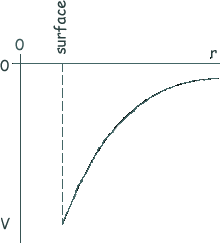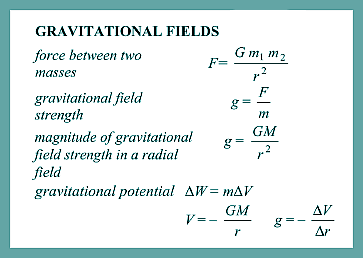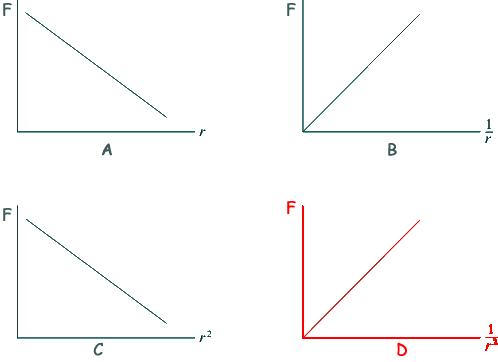Gravitational fields - Multiple Choice Q11. When at the surface of the Earth, a satellite has weight W and gravitational potential energy U. It is projected into a circular orbit whose radius is equal to twice the radius of the Earth. Which line, A to D, in the table shows correctly what happens to the weight of the satellite and to its gravitational potential energy?
W = mg
W1r12 = W2r22 W1 = W r1 = r r2 = 2r ∴ Wr2 = W2 x 4r2 W2 = W/4
V = - GM/r and let us make the mass be 'm'
U = - mGM/r At height r above the surface it would be - mGM/2r = ½U In other words it would have halved. So it changed by ½U Choice B Q12. The sketch graph shows how the gravitational potential, V, varies with the distance, r , from the centre of the Earth.
What does the gradient of the graph at any point represent?
V = - GM/r so Vr = a negative constant and the graph of an inverse relationship is shown in the negative quadrant. You are asked about the gradient.
ΔV/Δr = - g Choice A
Q13. Near the surface of a planet the gravitational field strength is uniform and for two points, 10 m apart vertically, the gravitational potential difference is 3 J kg–1. How much work must be done in raising a mass of 4 kg vertically through 5 m?
Q14. What would the period of rotation of the Earth need to be if objects at the equator were to appear weightless?
mv2/r =mg so, v2/r =g
and v = root of rg = root of (6.37 x 106 x 9.81) = =7905
v = 2πr/T
T = 2π x 6.37 x 106 /7905 T = 5063 seconds T = 1.4 hours Choice B
Q15. The Earth has density ρ and radius R. The gravitational field strength at the surface is g. What is the gravitational field strength at the surface of a planet of density 2ρ and radius 2R?
density = mass/volume Volume depends on r3 density depends on mass/r3
We are told that the planet's density has doubled - that means that the mass must have increased by a factor of 16.
Choice C
Q16. Which one of the following graphs correctly shows the relationship between the gravitational force, F, between two masses and their separation r?
Q17. Which one of the following could be a unit of gravitational potential?
On the data sheet you have ΔW (work in joules) = VΔm (mass in kg) So the unit must be J kg–1 Q18. The radius of a certain planet is x times the radius of the Earth and its surface gravitational field strength is y times that of the Earth. Which one of the following gives the ratio
Mass = a constant x gr2
B is the solution
Q19. A planet of mass M and radius R rotates so rapidly that loose material at the equator only just remains on the surface. What is the period of rotation of the planet?
speed of rotation = circumference of the Earth/time period of rotation. So, v = 2πR/T and T = 2πR/v
mv2/R =mg so, v2 =gR
so v2 = GM/R and v = square root of (GM/R) Therefore T = 2πR / square root of (GM/R) T = 2πR x square root of (R/GM) T = 2π x square root of (R3/GM) Choice D
Q20. As a comet orbits the Sun the distance between the comet and the Sun continually changes. As the comet moves towards the Sun this distance reaches a minimum value. Which one of the following statements is incorrect as the comet approaches this minimum distance?
|
Follow me...
|










